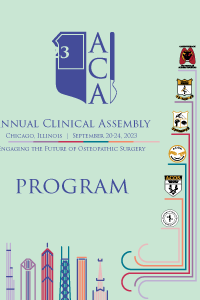Back
Introduction/Purpose: This study examines the relationship between weather patterns and trauma consults in Chicago. The focus is all trauma consults to a single institution (University of Chicago) from 2019-2022. Previous research has shown that trauma consults increase in warmer months, and other relationships such as higher rates of falls in icy conditions. However, very few have if any have completed a thorough investigation into the relationships between trauma and weather variables such as precipitation, visibility, snow, average temperature, moon phase. The null hypothesis is that weather has no association with types of trauma consults.
Methods or Case Description: Data on trauma consults is gathered by retrospectively reviewing and extracting data from the University of Chicago Electronic Medical Records from 2019-2022. The historical weather data source is visualcrossing.com which pulls data from National Oceanic and Atmospheric Administration (NOAA) and Deutscher Wetterdienst (DWD). Patients' age, gender, mechanism of injury, body part injured, and need for surgical intervention were examined. Weather variables of interest include daily temperature, precipitation, snow, moon phase, and conditions. Data were analyzed to identify patterns. Analysis was primarily completed using Excel, linear regression, and Chi Square analysis.
Outcomes: There were 11,512 total trauma consults from July 1, 2019, through July 1, 2022. Of these total consults, the mechanism of injury was 2875 falls, 1885 motor vehicle collisions, and 1361 gunshot wounds. There was a significant correlation between average monthly temperature number of daily trauma consults per month (R2=.863, p< .001). For each individual mechanism of injury, there was also a significant correlation between the average monthly temperature and the number of consults. There was a negative correlation between precipitation and number of consults per day. Additionally, there were 1.12 times as many GSWs on days with < .01 inch of precipitation. For patients < 65, there is a clear trend of increased traumas in warmer months. For patients >65yo, the rate of traumas was more consistent-year-round, and this may be due to a higher rate of falls in this population in the colder months. We found that contrary to the myth of full moons being associated with increased number of traumas, the number of traumas was not significantly different on days with full moon vs without X2(1,N=11488)=.685, p=.4080. There was a significantly higher proportion of hip injuries on days with snow than on days with no snow X2(1,N=3035)=4.493, p=.034, and a significantly lower proportion of shoulder/elbow injuries in the snow X2(1,N=2428)=6.024, p=.0141.
Conclusion: There is a significant correlation between increased temperature and number of trauma consults. Increased temperature has a significant association with an increased number of GSWs, MVCs, and Falls. There is an association of increased precipitation and decreased number of trauma consults. Rainy days had fewer gunshot wounds in this data set. We find that full moons are not significantly associated with the number of traumas in a day. On days with snow, there is a higher proportion of hip injuries and lower proportion of shoulder/elbow injuries. There is not a higher number of traumas in snow vs without snow, but this is likely due to the higher rate of traumas in warmer weather. Evaluating the number of traumas in snow vs non-snow days when the temperature is under 32F may help further elucidate this relationship. For some relationships, dividing the population by age exhibited slight differences. This data has practical applications. This study can be used to guide better resource allocation and OR access based on weather patterns. Additionally, the data may potentially be used in a predictive manner to identify likely traumas based on a day's weather forecast.
ACOS 2023 Annual Clinical Assembly
General Surgery
Podium Presentations - General Surgery
Climate and Crisis: How Weather Patterns Affect Trauma Consults
Thursday, September 21, 2023
3:10 PM – 3:20 PM CT
Location: Chicago Ballroom D-H, 5th Floor

Alexandra Siavelis (she/her/hers)
Medical Student
Midwestern University Chicago College of Osteopathic MedicineDisclosure(s): No financial relationships to disclose
Member Speaker(s)
Disclosure(s):
Alexandra Siavelis: No financial relationships to disclose
Learning Objectives:
- describe generally how weather patterns affect trauma consults.
- identify specific periods or seasons during which trauma consults are more likely to increase due to certain weather conditions.
- discuss potential ways to explain the correlations between weather and trauma patterns.
Methods or Case Description: Data on trauma consults is gathered by retrospectively reviewing and extracting data from the University of Chicago Electronic Medical Records from 2019-2022. The historical weather data source is visualcrossing.com which pulls data from National Oceanic and Atmospheric Administration (NOAA) and Deutscher Wetterdienst (DWD). Patients' age, gender, mechanism of injury, body part injured, and need for surgical intervention were examined. Weather variables of interest include daily temperature, precipitation, snow, moon phase, and conditions. Data were analyzed to identify patterns. Analysis was primarily completed using Excel, linear regression, and Chi Square analysis.
Outcomes: There were 11,512 total trauma consults from July 1, 2019, through July 1, 2022. Of these total consults, the mechanism of injury was 2875 falls, 1885 motor vehicle collisions, and 1361 gunshot wounds. There was a significant correlation between average monthly temperature number of daily trauma consults per month (R2=.863, p< .001). For each individual mechanism of injury, there was also a significant correlation between the average monthly temperature and the number of consults. There was a negative correlation between precipitation and number of consults per day. Additionally, there were 1.12 times as many GSWs on days with < .01 inch of precipitation. For patients < 65, there is a clear trend of increased traumas in warmer months. For patients >65yo, the rate of traumas was more consistent-year-round, and this may be due to a higher rate of falls in this population in the colder months. We found that contrary to the myth of full moons being associated with increased number of traumas, the number of traumas was not significantly different on days with full moon vs without X2(1,N=11488)=.685, p=.4080. There was a significantly higher proportion of hip injuries on days with snow than on days with no snow X2(1,N=3035)=4.493, p=.034, and a significantly lower proportion of shoulder/elbow injuries in the snow X2(1,N=2428)=6.024, p=.0141.
Conclusion: There is a significant correlation between increased temperature and number of trauma consults. Increased temperature has a significant association with an increased number of GSWs, MVCs, and Falls. There is an association of increased precipitation and decreased number of trauma consults. Rainy days had fewer gunshot wounds in this data set. We find that full moons are not significantly associated with the number of traumas in a day. On days with snow, there is a higher proportion of hip injuries and lower proportion of shoulder/elbow injuries. There is not a higher number of traumas in snow vs without snow, but this is likely due to the higher rate of traumas in warmer weather. Evaluating the number of traumas in snow vs non-snow days when the temperature is under 32F may help further elucidate this relationship. For some relationships, dividing the population by age exhibited slight differences. This data has practical applications. This study can be used to guide better resource allocation and OR access based on weather patterns. Additionally, the data may potentially be used in a predictive manner to identify likely traumas based on a day's weather forecast.

